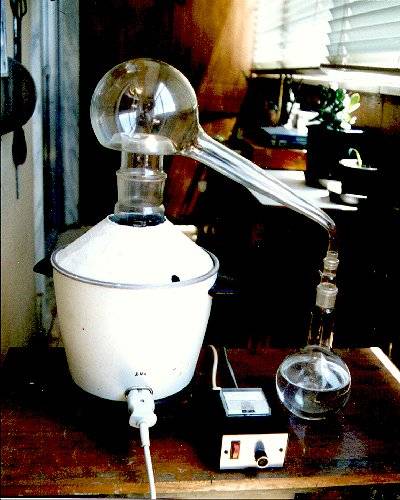Six Litre Alembic
Consecutively, we will explain to you how to
built three different kinds of electric heaters. The first and larger one is for the
cucurbit (balloons) of 6 litres, the second one for a 2 or 3 litres and the other smaller,
for a matrass and 500ml retorts.
The first heater is made with a 1 or 2 kW electric
frying cooker that will be very easy to order at a suitable supplier. It is destined to do
the distillations of essential oils, the wine and the vinegar. This heater is indispensable,
because these distillations cannot be made in a cucurbit of a smaller capacity.
Before buying the electric frying cooker, acquire
a good quality 6-litre Pyrex glass balloon, with plane bottom. Only then, should you buy
the frying cooker, so that you may verify that the cucurbit (balloon) enters and fits well
into it.
Pay attention! You should never connect your heater
directly to the power supply outlet in the wall. The thermostat installed in the frying
cooker is not suitable to regulate properly the necessary temperature for the
distillations.
You will need to install, between the heater and
the outlet, a 1 kW electronic voltage regulator. This regulator can be acquired at a
suitable supplier or made by an expert electronic technician.
The referred regulator will allow you to regulate
the voltage of the electric current between 0 and 220V (110V in USA), in a way that you
will obtain the suitable temperature in the heater for each case. In this way, you can
regulate and make the distillation of the essential oils, the wine and of the vinegar.
With relationship to the other heater for 2 and 3
litre cucurbit, we suggest that you, in the beginning, make it for a 2-litre cucurbit.
Later, you can build another one for a 3 litre, if you have a need for it.
The first heater will be used for an alembic
composed of a 6-litre cucurbit, 2-litre helm and a 2-litre recipient. In the 6 litres
balloon with plane bottom (cucurbit), that you have acquired already, you had ordered also
to the master glass blower, a wheelwork female, IN70 mm. You had also ordered to place
along the side of the cucurbit in the upper part of the belly, a small glass tube that is
either screwed in or part of the glass, to place in a 0-150°C thermometer.
You will have to order the making of a helm with
the capacity of 2 litre with wheelwork male IN70, with a throat of 30 cm of length,
finishing in a curved point or beak, with a IN19 male, just as you can observe it in the
picture.

A glass balloon Pirex of plane bottom will
constitute the recipient or receiving matrass, with a capacity of 2 litres with IN29
female end. To adapt the recipient to the helm, you will use a reducer of IN29mm female at
one end and a IN29mm male at the other end, with a small breather placed in the body of
the adapter, between the two wheelworks.
The breather is absolutely necessary. Pay a lot
of attention! One should never distil in a recipient without a breather, because when the
pressure builds up inside the alembic and increase, it needs to have an escape to leave
slowly, otherwise the glass will explode.
With precaution, have a plate of asbestos of 1,5
mm in thickness, cut with a strong scissors two strips of 50 cm of length by 5 cm of width
and nail them in the centre in a cross or ?X? shape, with a metal staple. Place
the "cross" at the bottom of the heater, so that the ribbons continue in a
vertical position, up the lateral wall.
Seat also, in the bottom of the heater, on top of
the ribbons in a cross shape, a slice of asbestos, of the diameter of the bottom of the
frying cooker. This way, the cucurbit will be isolated from the walls of the heater and will
maintain an air space all around it, bottom and sides, avoiding, like this, that the glass
be in direct contact with the metal.
After having placed the cucurbit inside of the
heater, make a cone of asbestos or of fine aluminium to cover it, but take care of leaving
in place two openings for the neck of the cuc?rbita and the other, for the thermometer
opening. Only, then will you install the helm along with the recipient, and take care of
applying silicon on all the joints.
For the circulations, we recommended a blind
helm, made of a spherical balloon of 2 litres, with IN70 male end and a capillary air hole
in the top.
Rubellus Petrinus
@nifo@innergarden.org
Inner Garden Foundation
P.O. Box 8520, 3542AD
Utrecht, The Netherlands